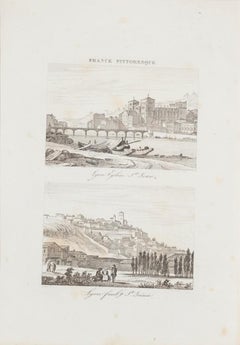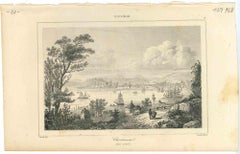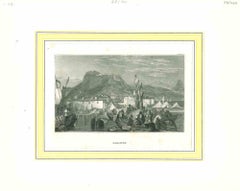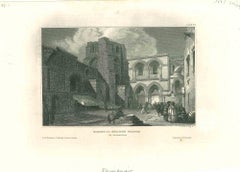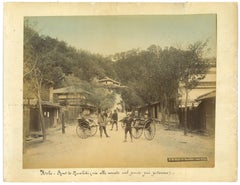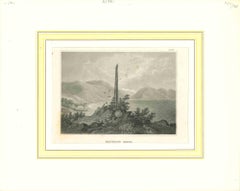19th Century Landscape Prints
to
100
1,440
428
103
39
16
Overall Width
to
Overall Height
to
889
83
66
15
7
5
3
2
58
56
33
30
22
974
2,041
9,718
4,074
114
120
682
512
590
1,116
1,544
1,660
1,152
576
632
1,422
597
5
1,194
434
359
277
240
182
177
166
139
132
131
128
108
100
98
95
93
83
80
76
1,016
649
292
194
101
187
1,211
843
636
Period: 19th Century
Lyon - Original Lithograph - 19th Century
Located in Roma, IT
Lyon is an original lithograph realized by an Anonymous artist in 19th Century.
Belongs to the Series "France Pittoresque", as indicated in the top center.
Titled in France on the ...
Category
19th Century Landscape Prints
Materials
Lithograph
Ancient View of Christiania - Original Lithograph on Paper - Early 19th Century
Located in Roma, IT
Ancient View of Christiania is an original modern artwork realized in the first half of the 19th Century.
Original Lithograph on Ivory Paper.
Inscripted on the lower margin: Chri...
Category
Modern 19th Century Landscape Prints
Materials
Lithograph
Ancient View of Corynth - Original Lithograph - Mid-19th Century
Located in Roma, IT
Ancient View of Corynth is an original modern artwork realized in the first half of the 19th Century.
Original B/W Lithograph on Ivory Paper.
Inscripted on the lower margin in Ca...
Category
Modern 19th Century Landscape Prints
Materials
Paper, Lithograph
The Church of the Holy Grave - Original Lithograph - Mid-19th Century
Located in Roma, IT
Ancient View of the Church of the Holy Grave is an original modern artwork realized in the mid 19th Century.
Original B/W Lithograph on Ivory Paper.
Ins...
Category
19th Century Landscape Prints
Materials
Paper, Lithograph
Ancient Views of Kobe - Vintage Albumen Print - 1890s
Located in Roma, IT
Ancient Views of Kobe is an original vintage albumen print on single cardboard: 26 x 34 cm.
They were realized in the 1890s.
Good conditions e...
Category
19th Century Landscape Prints
Materials
Cardboard, Photographic Paper
Ancient View of Frithiofs Bauta - Original Lithograph - Early 19th Century
Located in Roma, IT
Frithiofs Bauta is an original modern artwork realized in the first half of the 19th Century.
Original Lithograph on Ivory Paper.
Inscripted on the lower margin in Capital Letter...
Category
Modern 19th Century Landscape Prints
Materials
Lithograph
Ancient View of Kobe - Vintage Albumen Print - 1890s
Located in Roma, IT
Ancient Views of Kobe is an original vintage Albumen print on single cardboard: 26 x 34 cm.
They were realized in the 1890s.
Good conditions ex...
Category
19th Century Landscape Prints
Materials
Cardboard, Photographic Paper
Ponte di Mammea (today Ponte Mammolo) - Original Etching by A. Acquaroni - 1836
By Antonio Acquaroni
Located in Roma, IT
The original artwork Ponte Mammea oggi Ponte Mammolo is an etching on copper, drawn and engraved by the artist Antonio Acquaroni (signed Aquaroni), for the print series Ponti antichi...
Category
19th Century Landscape Prints
Materials
Etching
Ancient View of Messina - Original Lithograph on Paper - Mid-19th Century
Located in Roma, IT
Messina is an original modern artwork realized in Italy in the first half of the 19th Century.
Original Lithograph on Ivory Paper.
Inscripted on the lower margin in Capital Lette...
Category
Modern 19th Century Landscape Prints
Materials
Lithograph
French Palaces - Original Lithograph - 19th Century
Located in Roma, IT
French Palaces - France Pittoresque is an original lithograph artwork realized by an Anonymous artist of the 19th century. Four images are included on a single sheet.
Printed in ser...
Category
Modern 19th Century Landscape Prints
Materials
Paper, Lithograph
Landscape - Original Lithograph on Paper by E. Laport - 1860
Located in Roma, IT
Landscape is an original lithograph on paper, realized by E.Laport in about 1860.
The state of preservation is good except for some diffused stains.
Hand-colored.
Plate no.7.
Sh...
Category
19th Century Landscape Prints
Materials
Lithograph
Rome, Palatine Hill - Original Etching and Dry-point by Cesare Biseo - 1898
Located in Roma, IT
Rome, Palatine Hill is a wonderful etching and dry-point on paper by realized by Cesare Biseo in 1898.
Hand-signed and dated with the description on the lower in pencil.
In very go...
Category
19th Century Landscape Prints
Materials
Drypoint, Etching
"Le Charpentier" original etching
Located in Henderson, NV
Medium: original etching. This impression on laid paper was printed by A. Salmon and published in Paris by L'Art ca. 1880. Size: 11 x 8 3/8 inches (image) -- 280 x 212 mm. Signed in ...
Category
19th Century Landscape Prints
Materials
Etching
Landscape - Original Woodcut by Shuko Yishi - 19th Century
Located in Roma, IT
Landscape is a reprint of a woodblock realized after Shuko Yishi (1564- ?)
The State of preservation is very good.
Included a passepartout: 50 x 32.5 cm
The artwork represents a p...
Category
Modern 19th Century Landscape Prints
Materials
Woodcut
Intérieur de Forêt - Original Etching by Diaz - 1880 ca
Located in Roma, IT
Intérieur de Forêt is an original etching realized after N. Diaz de la Pena in 1880 ca. Engraved by P. Leterrier.
Titled on the lower center.
The state of preservation is good.
Th...
Category
Barbizon School 19th Century Landscape Prints
Materials
Paper, Etching
Dio Ridicolo Temple - Etching by L. Cavalieri - 19th Century
Located in Roma, IT
Dio Ridicolo Temple is an etching realized by L.Cavalieri in the 19th Century.
Signed on the plate on the lower right corner. Tav.107
Good conditions except for margins which are a...
Category
Modern 19th Century Landscape Prints
Materials
Etching
Sepolcro Regio o Consolare (...) - Etching by Luigi Rossini - 1825
Located in Roma, IT
Sepolcro Regio o Consolare inciso nella rupe del Monte Albano, or nel Convento di Fr. Frances. ni di Palazzuolo is an original etching realized by Luigi Rossini.
From the series “Le ...
Category
Modern 19th Century Landscape Prints
Materials
Etching
07: The Victory
Located in Columbia, MO
Edward William Cooke was born in Pentonville. His father, George Cooke, and uncle William Bernard Cooke were also well-known line engravers. Growing up in an environment of artists,...
Category
19th Century Landscape Prints
Materials
Etching
Altra Veduta presa sotto... - Etching by Luigi Rossini - 1825
Located in Roma, IT
Altra Veduta presa sotto il grand' Arco dell'interno dell'Emissario di Albano is an original etching belonging to the series "Le Antichità di contorni di Roma” (…)".
Beautiful proof...
Category
Modern 19th Century Landscape Prints
Materials
Etching
Bombing of Tanger - Lithograph - 19th Century
Located in Roma, IT
Bombing of Tanger is an original Hand-colored lithograph on paper realized by an Anonymous artist of the XIX century.
Titled on the lower center.
The state of preservation of the...
Category
19th Century Landscape Prints
Materials
Lithograph
Landscape - Lithograph on Paper by E. Laport - 1860
Located in Roma, IT
Landscape is an original lithograph on paper, realized by E. Laport around 1860.
The state of preservation is good except for some diffused stains.
Hand-colored.
Plate no.12
She...
Category
19th Century Landscape Prints
Materials
Lithograph
St. Denis Le Bourbon - Hotel du Gouvernement- Original Lithograph - 19th Century
Located in Roma, IT
Maison is an original lithograph realized by an anonymous engraver of the XIX century.
Printed in series of "France Pittoresque" at the top center.
Titled in France on the lower ce...
Category
19th Century Landscape Prints
Materials
Lithograph
Chateau de Rochechouart - Original Etching - 19th Century
Located in Roma, IT
French castle is an original etching artwork realized by an anonymous engraver of the 19th Century.
Printed in series of "France Pittoresque" at the top center.
Included two images...
Category
19th Century Landscape Prints
Materials
Etching
Chapelle d'Arrens - Original Etching - 19th Century
Located in Roma, IT
Landscape is original etching artwork on paper realized by an Anonymous artist of the 19th Century.
Printed in series of "France Pittoresque" at the top center.
Titled in France o...
Category
19th Century Landscape Prints
Materials
Etching
Roman Temple - Vintage Offset Print after G. Engelmann - Early 20th Century
Located in Roma, IT
Roman Temple is an offset print artwork on paper, realized by Godefroy Engelmann.
the artwork is signed on the plate. In very good condition.
The artwork represents a roman temple....
Category
Modern 19th Century Landscape Prints
Materials
Offset
French Landscape - Original Lithograph - 19th Century
Located in Roma, IT
Landscape is an original lithography on paper realized by an Anonymous artist of the 19th Century.
Printed in series of "France Pittoresque" at the top center.
Titled in France on...
Category
19th Century Landscape Prints
Materials
Lithograph
La Mare dans la clairière - Etching after N. Diaz de la Pena - 1880 ca
Located in Roma, IT
La Mare dans la clairière is an original etching realized after a painting by Narcisse Diaz de la Pena in 1880 ca.
Signed on the plate. Title...
Category
Modern 19th Century Landscape Prints
Materials
Etching
Novembre
Located in Roma, IT
Signed the plate with the artist's monogram “TS”lower left. Inscription “C. Lovera imp” lower right. Very rare print from “L'Art in Italia”, 1871.Original Prints.
Image Dimensions : ...
Category
Realist 19th Century Landscape Prints
Materials
Etching
Defense of the Cemetery in Magenta - Lithograph by Carlo Perrin - 1860
By Carlo Perrin
Located in Roma, IT
Image dimensions: 15.5x22.5 cm.
Defense of the Cemetery in Magenta is a beautiful artwork realized by Carlo Perrin in 1860.
Hand colored litograph, published in Turin by Carlo Perr...
Category
19th Century Landscape Prints
Materials
Lithograph
Colmar - Etching - 19th Century
Located in Roma, IT
Colmar is a etching artwork realized by an anonymous engraver of the XIX century.
Printed in series of "France Pittoresque" at the top center.
Titled in France on the lower center....
Category
Modern 19th Century Landscape Prints
Materials
Etching
Landscape - Original Etching - 1879
Located in Roma, IT
"Landscape" is an original drawing in etching, realized by Edwin Edwards.
The state of preservation of the artwork is very good.
Sheet dimension: 18.5 ...
Category
Modern 19th Century Landscape Prints
Materials
Etching
On the Bank of Thames - Original Etching on Paper by Arthur Evershed - 1876
Located in Roma, IT
On the Bank of Thames is an original etching artwork on paper realized in 1876 by Arthur Evershed (1836-1919), printed by Delatre London.
Plate-signed on the lower right and dated....
Category
19th Century Landscape Prints
Materials
Etching
The Street, Chelsea - 1880s etching by Whistler follower Theodore Roussel
Located in London, GB
THEODORE CASIMIR ROUSSEL, RBA
(1847-1926)
The Street, Chelsea Embankment
Etching, signed in the plate, signed on the artist’s tab, trimmed to the platemark by the artist, framed
15...
Category
Realist 19th Century Landscape Prints
Materials
Etching
Ancient Map of Denmark and Sweden - Original Etching - 19th Century
Located in Roma, IT
This Map of Denmark and Sweden is an etching realized by an anonymous artist.
The state of preservation of the artwork is good with some small diffused stains.
Sheet dimension: 27x...
Category
Modern 19th Century Landscape Prints
Materials
Etching
Castel - Original Lithograph on Paper by F. Gonin - 1880
By Francesco Gonin
Located in Roma, IT
"Castel" is an original lithograph on paper, realized by Francesco Gonin in 1880.
Good conditions.
The artwork represents a magnificent castel, through harmonious hatchings by delica...
Category
19th Century Landscape Prints
Materials
Lithograph
Garden - Lithograph by M. Calderini - 1880 ca.
By Marco Calderini
Located in Roma, IT
Garden is a beautiful black and white lithograph on paper, realized by Marco Calderini (Tourin 1850-1948) around 1880.
Representing a luxurious and decadent garden with a central fo...
Category
19th Century Landscape Prints
Materials
Lithograph
30: Collier
Located in Columbia, MO
Edward William Cooke was born in Pentonville. His father, George Cooke, and uncle William Bernard Cooke were also well-known line engravers. Growing up in an environment of artists,...
Category
Naturalistic 19th Century Landscape Prints
Materials
Etching
Interieur de Geneve. Bourg De Four - Lithograph by Antonio Fontanesi - 1854
Located in Roma, IT
This splendid lithograph Interieur de Geneve. Bourg De Four is part of the series of 20 prints dedicated to views of the city of Geneva, engraved by the Italian artist Antonio Fontan...
Category
Old Masters 19th Century Landscape Prints
Materials
Lithograph
Shepherds with Flock - Etching - 19th Century
Located in Roma, IT
Sherpherds with flock is a beautiful etching on cream-colored paper, realized by an artist of the XIX century.
Image Dimensions: 37 x 46.5 cm
In good conditions, except for some tea...
Category
Old Masters 19th Century Landscape Prints
Materials
Etching
Interior of Geneve - Lithograph by Antonio Fontanesi - 19th Century
Located in Roma, IT
The Interior of Geneve is an original Lithpgrapg by Antonio Fontanesi in the 19th Century.
The state of preservation of the artwork is excellent. Image Dimensions: 15 x 21.5 cm
T...
Category
Modern 19th Century Landscape Prints
Materials
Lithograph
City Center - Original Lithograph - 19th Century
Located in Roma, IT
City Center is an enchanting lithograph on ivory-colored cardboard, realized by Anonymous Artist of the XIX Century.
Not Signed.
The artwork represents a fantastic City Center.
Th...
Category
Modern 19th Century Landscape Prints
Materials
Lithograph
Lac De la Geneve - Lithograph by Antonio Fontanesi - 19th Century
Located in Roma, IT
This splendid lithograph Lac De la Geneve is part of the series of prints dedicated to views of the city of Geneva, engraved by the Italian artist Antonio Fontanesi.
The state of pr...
Category
Modern 19th Century Landscape Prints
Materials
Lithograph
Ponte Lucano - Etching by L.Cavalieri - 19th Century
Located in Roma, IT
Ponte Lucano is an original etching realized by L.Cavalieri in the XIX century.
signed on the plate on the lower right corner. Tav.123
Good conditions except for margins that are a...
Category
Modern 19th Century Landscape Prints
Materials
Etching
Paris Landscape - Original Etching by Eugène Bléry - 1838
By Eugene Blery
Located in Roma, IT
Paris Landscape, Title Page" Eaus Fortes" is an original etching artwork on paper realized in 1838 by Eugène Bléry (1805-1887).
Signed on the plate lower center of the image.
The State of preservation is very good except for diffused foxing along the white margin which does not affect the image.
The artwork represents in an oval frame the landscape. The artwork is depicted skillfully through confident and precise strokes with harmonious composition.Eugène Stanislas Alexandre Bléry (Fontainebleau, March 3, 1805 - Paris, June 10, 1887) was a French engraver and draftsman.He also made large collections of etchings, such as Forests and landscapes and the surroundings of Fontainebleau, starting from his drawings or from works by Dutch authors such as Meindert Hobbema and Jacob van Ruisdael.
Category
Modern 19th Century Landscape Prints
Materials
Etching
Grand Quai - Lithograph - 19th Century
Located in Roma, IT
This splendid lithograph Grand Quai is part of the series of prints dedicated to views of the city of Geneva, engraved by the Italian artist Antonio Fontanesi.
The state of preserva...
Category
Old Masters 19th Century Landscape Prints
Materials
Lithograph
The Unsafe Tenement
Located in New York, NY
James Abbot McNeill Whistler (1834-1903), The Unsafe Tenement, etching, 1858. [signed in the plate lower right]. References: Kennedy 17. Glasgow 18, fourth state (of four). In very good condition, printed on a very thin (two ply?) Japan paper, with margins, 6 1/8 x 8 3/4, the sheet 8 1/4 x 11, archival mounting.
A brilliant, black impression printed with astonishing clarity and exquisite detailing, on an ivory Japan paper. Presumably this is a proof impression before the relatively large edition published in this state (the edition was not on this paper).
Provenance: Inscribed “To Otto J. Schneider from his friend Frederick Keppel”. Schneider (1875-1946) was an American artist, noted for his realism, influenced by Whistler. Keppel was of course the well-known American dealer, one of whose specialties was Whistler prints. Keppel had a good relationship with Whistler until, as in most of his relationships, Whistler became inordinately troublesome – at which point Keppel wrote Whistler a longish, mocking poem, with lines such as these: “Like cackling hens or cocks a-crowing Your tireless trumpet keeps a-blowing. ” After this, Keppel wrote “at this point all my intercourse with this extraordinary man came to an end.”
(In the lower right is the ghost of another inscription, now erased, apparently to another friend from Edna (?) Schneider who presumably owned this print after Otto Schneider...
Category
Realist 19th Century Landscape Prints
Materials
Etching
(after) John Constable mezzotint "Autumnal Sun Set"
By David Lucas
Located in Henderson, NV
Medium: mezzotint (engraved by David Lucas after the John Constable painting). Printed in 1855 on cream wove paper for the "English Landscape S...
Category
19th Century Landscape Prints
Materials
Mezzotint
58: Schooner & Smack
Located in Columbia, MO
Edward William Cooke was born in Pentonville. His father, George Cooke, and uncle William Bernard Cooke were also well-known line engravers. Growing up in an environment of artists,...
Category
Naturalistic 19th Century Landscape Prints
Materials
Etching
Mausoleum of Theodore in Ravenna - Lithograph - 19th Century
Located in Roma, IT
The Mausoleum of Theodore is an original print on paper realized by an Anonymous. titled on the lower of image.
In very good conditions.
Sheet dimension: 16.5x 24.5 cm
The artwork...
Category
19th Century Landscape Prints
Materials
Lithograph
Russian Guards - Lithograph - 19th Century
Located in Roma, IT
Imperial Guards is an original print on paper realized by an Anonymous. titled on the lower of image.
In very good conditions.
Sheet dimension: 18 x 25.5 cm
The artwork represents...
Category
19th Century Landscape Prints
Materials
Lithograph
Laburnums at Battersea
Located in London, GB
THEODORE ROUSSEL, RBA
(1847-1926)
Laburnums at Battersea
Etching, signed in the plate, trimmed to the plate mark and signed and inscribed on the tab: Theodore Roussel Inv. Between...
Category
Aesthetic Movement 19th Century Landscape Prints
Materials
Etching
Geneva, Cour Du Collège - Lithograph by A. Fontanesi - 1854
Located in Roma, IT
This splendid lithograph Interieur de Geneve. Cour Du Collège is part of the series of 20 prints dedicated to views of the city of Geneva, engraved by the Italian artist Antonio Font...
Category
Naturalistic 19th Century Landscape Prints
Materials
Lithograph
En Provence; la Maison d'Orléans (Valognes)
Located in Middletown, NY
Etching in brownish black ink on cream laid paper, 5 3/8 x 3 1/2 inches (135 x 87 mm), partially trimmed lower sheet edge. With the artist's moniker in ...
Category
French School 19th Century Landscape Prints
Materials
Handmade Paper, Etching
La Cava (The Cave) - Etching by Francesco Mochetti - 1843
Located in Roma, IT
Image dimensions: 14.7 x 19.8 cm.
La Cava is an original black and white etching on paper, printed in 1843 as a plate of the print suite "90 Views of the citi...
Category
Modern 19th Century Landscape Prints
Materials
Etching
Hotel Saint-Charles - Original Woodcut Print by A. Deroy - 1880
Located in Roma, IT
Hotel Saint-Charles is a beautiful black and white xylograph on paper, realized in 1880 by Auguste Victor Deroy.
Original title: Nouvelle-Orléans: Hôtel Saint-Charles
Signed on pl...
Category
Modern 19th Century Landscape Prints
Materials
Woodcut
15: West Indiaman
Located in Columbia, MO
Edward William Cooke was born in Pentonville. His father, George Cooke, and uncle William Bernard Cooke were also well-known line engravers. Growing up in an environment of artists,...
Category
Naturalistic 19th Century Landscape Prints
Materials
Etching
10: Thames Barge
Located in Columbia, MO
Edward William Cooke was born in Pentonville. His father, George Cooke, and uncle William Bernard Cooke were also well-known line engravers. Growing up in an environment of artists,...
Category
Naturalistic 19th Century Landscape Prints
Materials
Etching
Liber Veritatis - Original B/W Etching after Claude Lorrain - 1815
Located in Roma, IT
Image dimensions: 21 x 27 cm.
Liber Veritatis - Plate 95 is a beautiful black and white etching and aquatint on paper realized by the Italian artist Ludovico Caracciolo, after Claud...
Category
Old Masters 19th Century Landscape Prints
Materials
Etching, Aquatint
Die Festung Coburg - Original Etching 19° Century
Located in Roma, IT
Image dimensions: 12.5x17.5 cm.
Die Festung Coburg is a beautiful black and white lithograph on paper, realized at the end of XIX century by the German landscapist artist, Georg Mic...
Category
Modern 19th Century Landscape Prints
Materials
Etching
Birds Eye View of Cheshire Connecticut 1882 lithograph pub. by O. H. Bailey
Located in Paonia, CO
View of Cheshire, Connecticut, 1882. Original lithograph was drawn and published by O. H. Bailey & Co. , a prominent 19th century map maker. The map shows a bird’s eye view of the town as it used to be, including street names and old landmarks. Beautifully colored historic map...
Category
Other Art Style 19th Century Landscape Prints
Materials
Lithograph
